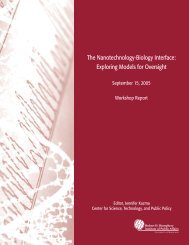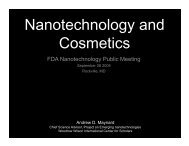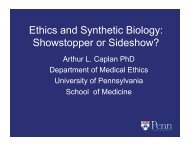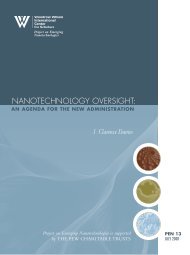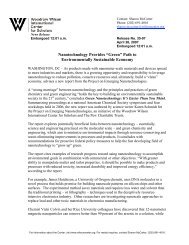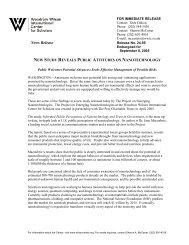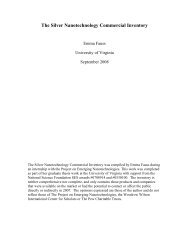Analysis of Nanotechnology from an Industrial Ecology ... - denix
Analysis of Nanotechnology from an Industrial Ecology ... - denix
Analysis of Nanotechnology from an Industrial Ecology ... - denix
You also want an ePaper? Increase the reach of your titles
YUMPU automatically turns print PDFs into web optimized ePapers that Google loves.
DRAFT - Inventory <strong>an</strong>d Evaluation <strong>of</strong> Life Cycle Assessments <strong>of</strong> N<strong>an</strong>otechnologies<br />
indicated that welders dealing with chemical inputs with these n<strong>an</strong>omaterials face some <strong>of</strong> the<br />
greatest exposure <strong>an</strong>d risk (Carnah<strong>an</strong> 2005).<br />
Because <strong>of</strong> potential health risks associated with various n<strong>an</strong>omaterials—such as buckyballs with<br />
their durability <strong>an</strong>d application in pharmaceutical products, <strong>an</strong>d metal oxides used in<br />
sunscreens—LCAs, risk assessments, <strong>an</strong>d subst<strong>an</strong>ce flow <strong>an</strong>alyses should further evaluate these<br />
n<strong>an</strong>otechnologies. It would also be interesting to assess carbon n<strong>an</strong>otube-based products in<br />
greater detail because they are making their way into so m<strong>an</strong>y applications. Cientifica affirms<br />
that “big markets, apart <strong>from</strong> materials, in which n<strong>an</strong>otubes may make <strong>an</strong> impact, include flat<br />
p<strong>an</strong>el displays (near-term commercialization is promised here), lighting, fuel cells <strong>an</strong>d<br />
electronics,” (2004). As described in a recent Environmental Health Perspectives publication,<br />
carbon n<strong>an</strong>otubes are considered “one <strong>of</strong> the most widely used <strong>an</strong>d researched engineered<br />
n<strong>an</strong>oparticles” (Hood 2004). Based on this <strong>an</strong>alysis <strong>of</strong> LCAs, I evaluated the feasibility <strong>of</strong><br />
performing a subst<strong>an</strong>ce flow <strong>an</strong>alysis on carbon n<strong>an</strong>otubes in a follow-up study.<br />
The results <strong>of</strong> this LCA inventory paper indicate that, in the <strong>an</strong>alysis <strong>of</strong> n<strong>an</strong>otechnology using a<br />
life cycle approach, more attention is needed. Few LCAs have been completed that are publicly<br />
available. The existing LCAs do not assess n<strong>an</strong>o-specific impacts, such as those related to<br />
hazardous potential <strong>of</strong> n<strong>an</strong>oparticles. The performed LCAs also assess fewer products <strong>an</strong>d life<br />
stages th<strong>an</strong> expected since n<strong>an</strong>omaterials are being used in the development <strong>of</strong> so m<strong>an</strong>y products.<br />
Future LCAs <strong>an</strong>d qualitative assessments should focus on evaluating specific hum<strong>an</strong> health <strong>an</strong>d<br />
environmental impacts <strong>an</strong>d risks associated with n<strong>an</strong>o-based inputs <strong>an</strong>d products during<br />
prem<strong>an</strong>ufacture activities, product m<strong>an</strong>ufacture, packaging <strong>an</strong>d tr<strong>an</strong>sport, use, <strong>an</strong>d recycling <strong>an</strong>d<br />
disposal. These efforts will help inform <strong>an</strong>d improve safe development, m<strong>an</strong>agement, <strong>an</strong>d use <strong>of</strong><br />
n<strong>an</strong>otechnology as this field moves forward.<br />
19



